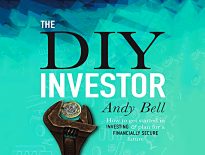DIY Investor 3 – Stocks, Bonds, Cash, Alternatives and Tax

Today’s post is our third visit to The DIY Investor by Andy Bell.
Stocks
Chapter 11 of Andy’s book is about equities – also known as stocks and shares.
A limited company’s owners are its shareholders, so when you buy shares you become a part-owner of the company.
Investors can profit from holding shares in two ways when the company pays a dividend and when the value of its shares increases.
There are two key advantages of shares:
- The pooling of risk amongst all the investors
- Limited liability so that if the company goes bust, the shareholders don’t lose their houses.
These concepts underpin modern capitalism.
Stocks have the highest returns of any asset class, but these returns are very variable (volatile) and stock markets are prone to regular serious crashes of 30% to 50% in a year.
- Those within living memories include 1973-74, 1987, 2000, 2002 and 2008.
You can read more about stocks here and here.
Andy describes the history of stocks, and the main UK markets and indices:
- The FTSE-100 holds the largest stocks, many with an international outlook.
- The FTSE-250 is the next batch down, and these are mostly UK-focused stocks.
- The AIM market for the smallest companies has tax advantages (no stamp duty and IHT exemption), but only a minority of its listings are of high quality.
Most private investors should steer clear of international stocks (on an individual basis, rather than through funds).
- They will be expensive to trade and you will have inferior information compared to locals.
- There is also FX risk, but this is not necessarily a bad thing.
The only plausible exception is the US market.
Andy also describes the process of buying and selling shares, but since the arrival of the internet, this has become very simple.
It is probably worth knowing about limit orders (where you only buy up to a certain price) and stop losses (where you sell if the price falls to a given level).
Andy also talks about level 2 data (visibility of the order book, not just the current price).
- This is not cheap, and only useful if you are a frequent trader.
He also discusses ratio analysis (stock screening), which is useful for generating stock ideas for further research.
- The PE ratio and the dividend yield are the only two ratios that he covers in detail.
He talks about dividends at some length.
- But as we have previously covered, Dividends Don’t Matter.
Private equity
Private Equity is another form of equity, one that is not listed on a stock exchange.
You can also read more about it here.
Corporate Actions
There are three corporate actions that private investors need to know about:
- Rights issues offer more shares to existing shareholders (if they will stump up the cash for them)
- An open offer is similar, but you don’t have (resellable) rights to your share of the new equity (though your share is still guaranteed)
- A takeover offer comes from a rival firm who wants to buy your shares
- it usually takes place at a significant premium to the share price before the offer, so it can be good news
- you don’t have to accept the offer (unless 75% of shareholders have done so already)
- it can be bad news if the offer is partly in shares, especially if they are foreign-listed shares
Bonds
Bonds are debts issued by governments and companies.
- You lend these people money in return for regular interest payments (the coupon – bonds used to come with detachable coupons that were exchanged for the interest payment).
- The bond is the promise to pay you back.
At the end of a fixed period (the maturity date), your capital (the principal) is returned.
- The key risk you take as a bondholder is that your counterparty will not be around at the end of the term to return your capital.
This is known as default risk.
- Lenders are rated according to their safety level by rating agencies (S&P, Moody’s etc).
Lending to a riskier entity will usually result in a higher yield.
- But as we saw in the 2008 crisis, ratings are not entirely reliable.
in addition, the bonds are resellable in a secondary market.
- The price paid will depend on interest rates and how they have changed since the bond was issued.
- This interest rate risk is the second key risk for bonds.
A 5% bond will pay £5 in interest for every £100 that you hold.
- If interest rates go up, this 5% yield will become less attractive, and the price of the bond will fall below £100 (below par).
- This means that a new buyer receives a higher effective yield (known as the running yield).
The change in the running yield also results in a new yield to maturity (YTM, also known as gross redemption yield).
- This is the annual return you would receive if you buy the bond and hold it until it matures – the “lock-in” rate.
- Note that the calculation assumes you can reinvest dividends at the same rate, which might not be possible.
UK government bonds are known as gilts (they used to have gold around the edges).
- High yield (risky) bonds are known as junk bonds.
There are also bonds where the interest is linked to inflation.
- These are known as index-linked bonds or linkers.
Bonds used to be sold in £10K to £590K chunks, but the London Stock Exchange introduced an Order Book for Retail Bonds (ORB) in 2010.
- This typically has a minimum trade of £1K.
Unfortunately, the ORB hasn’t caught on, perhaps because interest rates (and hence bond yields) remain at historic lows.
- So most investors will access bonds via funds and ETFs.
You can read more about bonds here, here and here.
Cash
Cash has two advantages (liquidity and a government guarantee to £85K per bank) – and one serious disadvantage (low returns).
- You should only hold enough cash for your immediate needs and as an emergency fund (six months expenses is usually recommended).
Holding cash for the long term will mean that you end up poor.
You can always hold cash as part of your portfolio’s bond allocation (cash is essentially a very safe, very low yielding government bond) and when you are rebalancing your portfolio or think that markets are expensive and will fall soon.
- But don’t hold excess cash for the long term.
One exception to this rule is in retirement when you might consider holding a cash buffer of several years of expenses.
- This would allow you to have a high stock market allocation for the rest of your portfolio.
- And it would enable you to ride out a bear market in stocks without selling near the lows.
NS&I
The National Savings and Investments organisation (NS&I) offers alternatives to cash which also carry a UK government guarantee.
- Probably the most interesting are Premium Bonds, where the interest on the accounts is raffled each month, with a few large prizes included in amongst a lot of much smaller ones.
Index-linked savings certificates used to be available (RPI plus 1.35%, tax-free, for example) but not any more.
Alternatives
Andy has a different interpretation of the term alternative investments to me.
I mean financial instruments whose returns are not well correlated with equities.
- So that they can be used to bring down the volatility of a portfolio and improve its Sharpe ratio.
- Examples include VC, private equity, real estate, commodities, metals, infrastructure and hedge funds.
Andy means real assets, that you can touch and feel.
- These are much harder to hold inside tax wrappers and are not suitable for the typical private investor.
Buy-to-let
Buy-to-let property (BTL) was a great investment twenty years ago, and many people have made fortunes this way.
- But the immediate prospects of property as an asset class are now much worse.
- And the government is changing the tax rules to make it less attractive.
Property is also lumpy (high unit value), illiquid and has very high transaction costs.
- You can read more about BTL here.
SWAG
Andy discusses stamps, wine, vintage cars, art and commodities (largely physical gold, plus coins) in the next section.
- You can safely ignore these investments.
Tax
The tax system for private investors in the UK is as simple as it’s ever been – at least during the accumulation phase.
You can put £20K pa into an ISA, and £40K pa into a SIPP.
- This should be more than enough for anyone, and you won’t have to worry about tax until you retire.
- You even get income tax relief on your SIPP contributions.
Drawing your pension is a bit more complicated.
- Pension income is taxable.
- And there is a lifetime limit (the LTA – currently £1.055M) on what you can withdraw from a pension before a penalty tax is applied).
Outside of SIPPs and ISAs, you will be taxed on dividends above £2K pa, interest above £1K pa and capital gains above £12K.
- The best strategy is to invest in growth assets and sell enough each year to use up your CGT allowance.
You can additionally reduce your income tax bill by investing in VCTs and/or EIS/SEIS.
- VCT and EIS offer 30% relief and SEIS 50% relief.
Conclusions
We’re three-quarters of the way through the book now, with one more article to come (plus a summary).
In the final article, we’ll look at tying it all together.
- Until next time.














